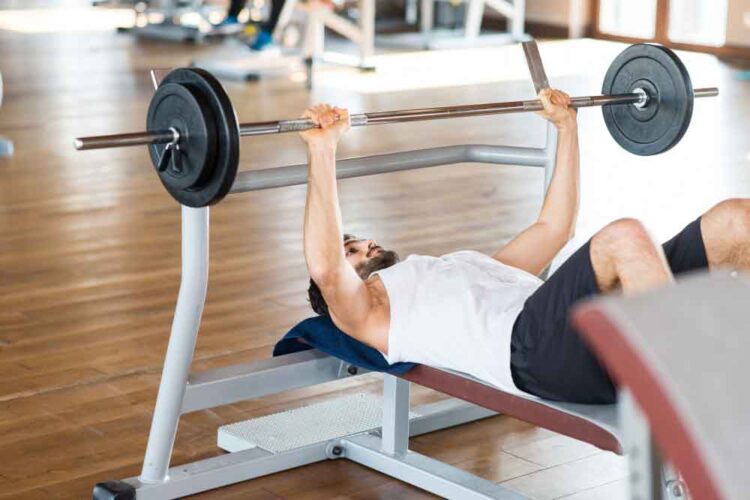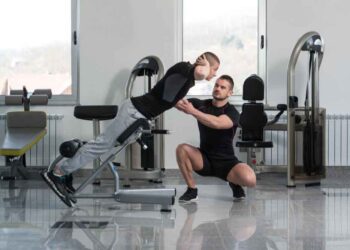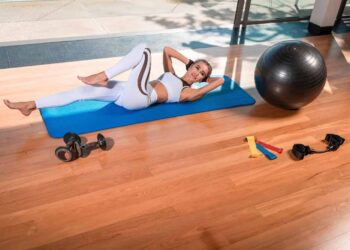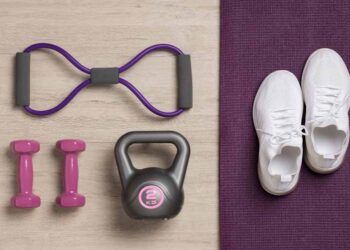Are you tired of spending endless hours at the gym without seeing the muscle gains you desire? Are you looking for a proven bench press routine that can take your strength and physique to the next level?
The bench press is hailed as the holy grail of upper body exercises, known for its ability to build a powerful chest, sculpted triceps, and well-developed shoulders. But with so many variations and techniques out there, how do you know which bench press routine will deliver the massive gains you crave?
In this article, we will explore the expert-endorsed bench press routine that guarantees impressive results. From the history and evolution of the bench press to the muscles worked and the best technique for maximum strength, we will cover it all. Get ready to take your bench press game to new heights!
Key Takeaways:
- Discover the history and evolution of the bench press and how it became the go-to exercise for chest development.
- Understand the muscles targeted by the bench press and how different rep ranges can optimize growth in various muscle groups.
- Learn the best technique for a strong bench press, including grip width, foot placement, and shoulder positioning.
- Explore the 5-3-1 workout method and how it can accelerate your bench press gains.
- Uncover the importance of assistance exercises and how they can enhance your bench press performance and overall strength.
The History and Evolution of the Bench Press
The bench press, one of the most popular resistance exercises worldwide, has a fascinating history and a rich evolutionary journey. This iconic strength-building lift gained prominence in the 1950s and quickly replaced the overhead press as the go-to upper body exercise for bodybuilders and actors.
The rise of bodybuilding as a sport, along with the emphasis on chest development and aesthetics, propelled the bench press to unmatched popularity. As bodybuilders and fitness enthusiasts focused on sculpting a bigger chest, the bench press became synonymous with strength, power, and muscle building.
Over time, weight benches with upright supports were introduced, providing stability and safety during bench press workouts. These advancements in equipment further solidified the bench press as the cornerstone of upper body training.
Today, the bench press continues to reign supreme as a staple exercise in bodybuilding, powerlifting, and strength training. Its effectiveness in targeting the chest, shoulders, and triceps muscles makes it a versatile and efficient compound lift.
The bench press has undergone significant evolution, from its origins as an upper body strengthening exercise to its current status as a symbol of chest development and strength.
The Evolution of the Bench Press: A Brief Timeline
| Decade | Milestone |
|---|---|
| 1950s | Emergence of the bench press as the primary upper body strength exercise |
| 1960s | Introduction of weight benches with upright supports |
| 1970s | Bench press gains popularity in powerlifting circles and competitive strength sports |
| 1980s | Bench press gains recognition as a fundamental exercise in fitness and strength training |
| 1990s | Scientific research highlights the biomechanics and muscle activation involved in the bench press |
| 2000s | Bench press variations and accessories gain attention for specific muscle targeting and sport-specific training |
As the history of the bench press continues to unfold, athletes, trainers, and fitness enthusiasts alike appreciate its integral role in building a powerful chest, enhancing upper body strength, and achieving remarkable physique transformations.
The Muscles Worked by the Bench Press
The bench press is an incredibly effective exercise for developing multiple muscle groups in the upper body. While it primarily focuses on the chest, it also engages the shoulders and triceps, making it a compound movement that delivers comprehensive results.
When performing the bench press, the chest muscles are the primary target. The exercise works the lower, mid, and upper chest, contributing to balanced chest development. By engaging these muscles, the bench press helps create a fuller and more defined chest appearance.
The front delts, or the front shoulder muscles, play a significant role in the bench press. They assist the chest in pressing the weight up, providing support and enhancing the overall movement. This activation helps develop the front delts, ultimately contributing to well-rounded shoulder development.
Additionally, the bench press heavily activates the triceps. While the primary focus is on the chest, the triceps muscles play a secondary role in pressing the weight up. Developing strong triceps through the bench press not only enhances pressing power but also improves overall arm strength.
It is important to note that the bench press also engages other muscle groups to a lesser extent. The sides of the shoulders, or the lateral delts, are activated during the movement. This activation contributes to shoulder development and adds to the overall aesthetic appeal of the upper body.
Furthermore, the bench press indirectly works the neck and the spinal erectors, which are the muscles along the spine. These muscles contribute to stability during the exercise and aid in overall back development.
To summarize, the bench press targets the chest, shoulders, and triceps, making it a comprehensive upper body exercise. By incorporating the bench press into a training routine, individuals can effectively develop these muscle groups, resulting in improved strength, muscle definition, and overall upper body aesthetics.
Muscles Worked by the Bench Press
| Muscle Group | Primary Focus | Secondary Engagement |
|---|---|---|
| Chest | Lower, mid, and upper chest development | – |
| Shoulders | Front delts activation | Lateral delts activation |
| Triceps | Secondary support during pressing | – |
| Other Muscles | – | Neck, spinal erectors (back stability) |
The Best Technique for a Strong Bench Press
When it comes to building maximum strength and achieving impressive gains in the bench press, technique plays a crucial role. By mastering the best bench press technique, you can optimize muscle activation and propel your performance to new heights.
Here are some key elements to focus on:
- Grip Width: To maximize power and stability, opt for a moderate grip width slightly wider than shoulder width. This grip allows for optimal leverage and muscle engagement.
- Leg Drive: Ensure your feet are firmly planted on the floor throughout the lift. This generates leg drive, providing a strong foundation for a powerful press.
- Lower Back Arch: Maintaining a modest arch in your lower back not only enhances stability but also creates a greater stretch in the chest muscles. This can facilitate greater muscle activation during the lift.
- Retract Shoulder Blades: Properly retracting your shoulder blades ensures a safer position and a deeper stretch in the chest. This allows for increased muscle activation and potential strength gains.
- Barbell Grip: Grip the barbell low in your hand and squeeze it as hard as possible. This technique helps maintain a straighter wrist position and improves grip strength, which is crucial for a strong bench press.
By implementing these techniques and ensuring their proper execution, you can optimize muscle activation and strengthen your bench press. Remember, consistency and attention to detail are key in achieving bench press greatness.
Check out the image below to see a visual representation of the best bench press technique.
| Benefits of the Best Bench Press Technique | Key Techniques |
|---|---|
| Maximized muscle activation | Grip width: moderate, slightly wider than shoulder width |
| Enhanced stability and safety | Leg drive: feet planted firmly on the floor |
| Greater stretch in the chest muscles | Lower back arch: modest arch for stability and chest stretch |
| Improved muscle engagement | Shoulder blades retracted: safer position and deeper chest stretch |
| Increased grip strength | Barbell grip: low in hand, squeezing the bar as hard as possible |
The 5-3-1 Workout Method for Bench Press Gains
The 5-3-1 workout method is a popular resistance training program that has been highly effective for intermediate and advanced lifters seeking bench press gains. This program is specifically designed for individuals who have an established one repetition maximum, making it suitable for those looking to take their bench press to the next level.
The 5-3-1 method incorporates key compound exercises, including the overhead press, bench press, deadlift, and squat, along with accessory exercises to target different muscle groups. By following a monthly cycle, the program introduces varying rep ranges each week, ensuring progressive overload and continual muscle stimulation.
One of the main advantages of the 5-3-1 method is its versatility in promoting both strength and hypertrophy gains. By performing accessory lifts with higher rep ranges, lifters can focus on muscular development and maximize their potential for muscle growth.
This program also ensures clear guidelines for progression, allowing lifters to easily track their results and make steady improvements in strength and muscle size over time. With consistent training, individuals can witness substantial bench press gains and achieve their desired goals.
Here is a breakdown of the 5-3-1 workout method:
- Week 1: Perform 3 sets of 5 reps at 65%, 75%, and 85% of your one repetition maximum.
- Week 2: Perform 3 sets of 3 reps at 70%, 80%, and 90% of your one repetition maximum.
- Week 3: Perform 1 set of 5 reps at 75%, 1 set of 3 reps at 85%, and 1 set with as many reps as possible (AMRAP) at 95% of your one repetition maximum.
- Week 4: Deload week where you perform lighter sets to recover and prepare for the next cycle.
It is important to note that the 5-3-1 workout method can be customized to meet individual needs and goals. Adjusting the percentages and rep ranges based on specific training preferences can help fine-tune the program to suit unique requirements.
By incorporating the 5-3-1 workout method into your training routine and consistently challenging yourself, you can unlock new levels of strength and achieve impressive bench press gains.
The Importance of Assistance Work for Bench Press
Assistance work plays a crucial role in developing strength and muscle in the bench press. By incorporating specific exercises that closely resemble the bench press, individuals can significantly improve their bench press performance and achieve their desired results.
1. Wide-Grip Paused Benches
Wide-grip paused benches are highly effective for enhancing bench press performance. This exercise helps to strengthen the chest, shoulders, and triceps muscles, which are key contributors to a strong bench press. By pausing at the bottom of each repetition, lifters can further increase their stability and build greater pressing power.
2. Narrow-Grip Touch-and-Go Bench Presses
Narrow-grip touch-and-go bench presses are another valuable assistance exercise for the bench press. This variation targets the triceps muscles, which are essential for providing secondary support during the bench press. Incorporating this exercise into a training routine can augment pressing power and aid in overall bench press improvement.
3. Incline Bench Pressing
Incline bench pressing targets the upper chest muscles and contributes to increased bench press strength. This exercise helps to develop the overall chest muscles, providing a well-rounded approach to bench press performance. By varying the angle of the bench, lifters can target different muscle fibers, leading to enhanced muscle development and improved bench press capabilities.
4. Overhead Pressing Variations
Overhead pressing variations, including the press behind the neck, also contribute to increased bench press strength. These exercises target the shoulders and triceps, reinforcing the muscles involved in the bench press. By incorporating overhead pressing variations into a training program, individuals can improve their pressing power and elevate their bench press performance.
5. Triceps Targeting Exercises
Targeting the triceps muscles through exercises like narrow-grip benches and dips can greatly enhance pressing power in the bench press. Strong triceps provide crucial support during the lift and play a significant role in achieving greater bench press performance. By focusing on triceps development, lifters can optimize their pressing strength and overall bench press gains.
When incorporating assistance work into a bench press routine, it is important to vary grip widths and reduce frequency and volume. This approach allows for optimal muscle recruitment and recovery, promoting continuous strength and muscle development. By strategically integrating these assistance exercises, individuals can enhance their bench press performance, develop greater strength and muscle, and unlock their full potential.
The Role of Bodyweight and Diet in Bench Press Progression
When it comes to bench press progression, two key factors often get overlooked: bodyweight and diet. These elements play a significant role in enhancing your strength and maximizing your bench press gains.
Increasing your bodyweight can actually improve your leverage and overall strength during the bench press. By adding quality bodyweight, you provide your muscles with additional mass, which can translate into a greater ability to move heavier weights. However, it’s important to focus on adding quality bodyweight rather than excessive fat. This means following a structured training routine coupled with a strategic approach to nutrition.
Proper nutrition is crucial for supporting muscle growth and development, which directly impacts your bench press performance. Consuming a nutritious diet that is rich in protein, healthy fats, and complex carbohydrates can provide your body with the necessary fuel to rebuild and repair muscle tissues. This, in turn, can lead to improved strength and performance in the bench press.
Remember, bench press progression is not solely about how much weight you can lift. It’s about fueling your body properly to support muscle growth and development. By focusing on your bodyweight and diet, you can push through plateaus and achieve greater bench press gains.
Next, let’s take a look at how bodyweight and diet can be further optimized to enhance your bench press performance.
Conclusion
The bench press is an incredibly versatile exercise that can be performed using various equipment and techniques. Whether you’re a beginner or an experienced lifter, incorporating a targeted bench press routine is essential for achieving significant gains in both strength and muscle size.
To optimize your bench press performance, it’s crucial to focus on proper technique. By maintaining the correct grip width, positioning your feet firmly on the floor, and retracting your shoulder blades, you can maximize muscle activation and avoid potential injuries.
In addition to technique, incorporating assistance exercises can further enhance your bench press gains. Exercises like wide-grip paused benches, narrow-grip touch-and-go bench presses, and incline bench presses can all contribute to improved strength and overall performance.
Lastly, don’t forget the importance of bodyweight and diet in your bench press progression. Adding quality bodyweight can improve leverage and strength, while following a nutritious diet can support muscle growth and development. By paying attention to these crucial factors, you can push through plateaus and achieve impressive bench press results.














